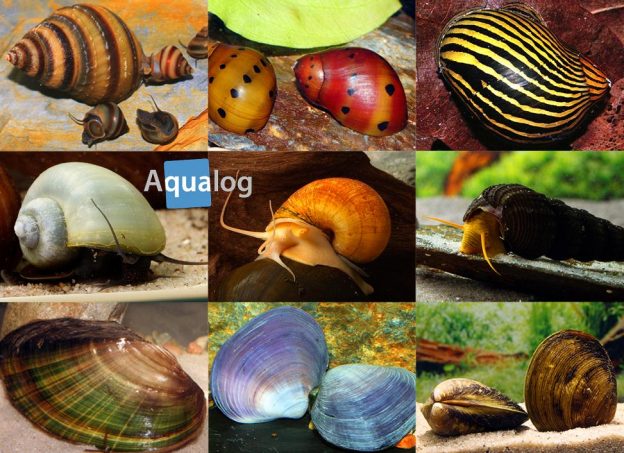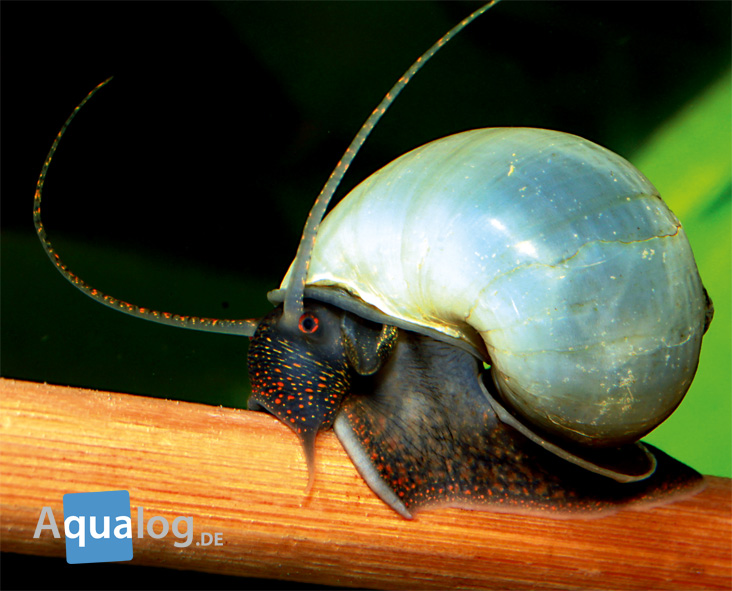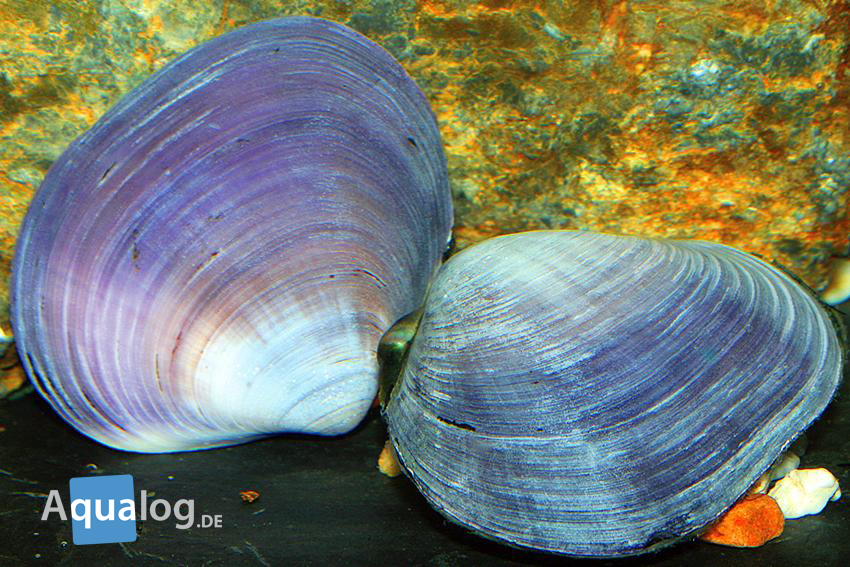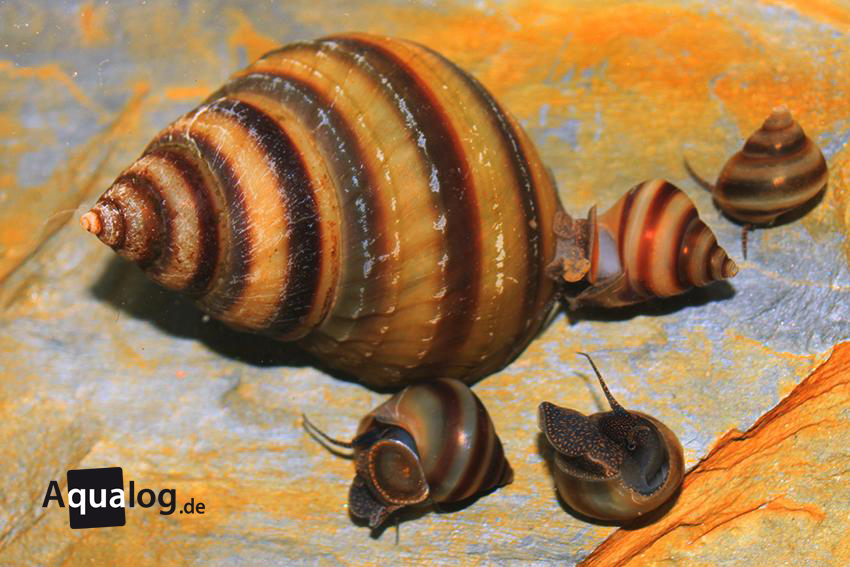
Since the very beginning of the aquarium hobby snails have been maintained in the aquarium to consume algae and wastes. Most aquaria are home to small, inconspicuous snails without the owner introducing them. But there are also large, attractive species that are deliberately imported and bred. These belong to a variety of families. Ramshorn snails (Planorbidae), pond snails (Lymnaeidae), and apple snails (Ampullariidae) are are-breathing snails that must regularly visit the water’s surface to take in air. By contrast the mystery snails (Viviparidae), whelks (Buccinidae), trumpet snails (Thiaridae), and nerites (Neritidae), breathe via gills. Reproduction takes place via eggs or by giving birth to fully-formed young. Nerites cannot breed in the aquarium, as their eggs hatch into free-swimming larvae that can develop only in sea water. The majority of snails are hermaphrodites, but there are some species with separate sexes.
The freshwater bivalves maintained in the aquarium belong to the basket clam family (Corbiculidae) and the river mussels or unionids (Unionidae). All mussels are filter-feeders and breathe via gills. Basket clams are live-bearers, while the larvae of river mussels live parasitically on fishes for a while.

Pomacea diffusa “blue”
Important requirements
The aquarium-water requirements of snails and mussels are broadly similar to those of fishes, although snails and mussels are generally less sensitive to more serious pollution of the water with germs. Essentially, hard, slightly alkaline water is beneficial for all species, as it facilitates shell formation, but some tropical species will also tolerate soft, slightly acid water.
Appropriate feeding
The snails maintained in the aquarium generally feed on vegetable material. The ramshorn and pond snails and the nerites are particularly good at grazing algae and will also consume (mainly dead) plant material. Apple snails feed on living plant tissue and hence often destroy aquatic plants. Mystery and trumpet snails feed mainly detritus, i.e. waste material of both plant and animal origin. All the species listed can readily be fed on food tablets and flake intended for ornamental fishes, Apple snails should be given additional meals of lettuce leaves (not sprayed with pesticides!) and the like. Whelks are predators that feel mainly on other snails, but in the absence of the latter will also take granules and frozen foods.
Mussels require micro-organisms, above all algae, as food. The best solution is to feed them “green water”, which can be created by adding a few drops of complete pot-plant fertiliser to a clear glass jar of mains water and leaving it so stand in full sunlight. The contents of the jar should be stirred briefly every day. After a few days the water will be deep dark green and ready for feeding. Another possibility is yeast soaked in milk, but that increases bacterial growth considerably. The aquarium trade sells various liquid preparations for rearing fish fry, and these can also be offered as supplementary foods.
Correct maintenance
Snails and mussels require no special maintenance. moderate water changes (1/4 to 1/5 of the aquarium volume weekly or every 14 days) are perfectly adequate. Note that aquaria for snails and mussels should not be too heavily filtered, so that there is always some mulm in the aquarium to supplement the diet. The water used for water changes should be around the same temperature as the aquarium water. A temperature difference of 3-4°C is acceptable, but the new water should always be cooler, never warmer, than the aquarium water. Snails and mussels react very badly to metal compounds in the water and to chemical additives. . Copper from new domestic pipework can be a particular problem. As many snails as possible and all the mussels should be removed from the aquarium should the fishes require treatment with medication, as it is always within the realm of possibility that such medications won’t be tolerated by snails and mussels.

Batissa violacea
Aquarium and tankmates
Snails can be kept in any standard aquarium. Very large apple snails have a high metabolic rate and need correspondingly large aquaria so that the water doesn’t go bad. Mussels require substrate of sand or fine gravel in which to bury themselves. The substrate should be at least half the length of the mussel in depth. In the wild Nerites often live in the zone between the high and low tide lines and are inclined to crawl out of the aquarium, which accordingly should always be tightly covered.
Life expectancy
Very variable, depending on the species. Ramshorn and pond snails usually live for no longer than 1-2 years, while nerites and apple snails can live for several years. Some freshwater bivalves are among the longest-lived animal species on this planet and can live to 150-200 years old, but the species in question aren’t maintained in the aquarium. The normal aquarium river mussels usually live for 15-20 years, and basket clams for 3-7 years.
Size
The majority of the snail species kept in the aquarium grow to 3-4 cm long, although some large trumpet snails reach a length of 7-8 cm and some apple snails can attain the size of a man’s fist. River mussels grow to between 5 and 30 cm long, depending on the species, while basket clams grow to a maximum of 5 cm long.

Taia naticoides
Special details
Snails and mussels acquired via the pet trade should never and under no circumstances whatsoever be released into the wild. They can cause damage to plants, transmit diseases, and constitute a threat to native species. In the event of excessive proliferation (“a plague of snails”) then snail-eating fishes (loaches of the family Botiidae, puffers) or Assassin Snails (Anentome helena) can be introduced. The surplus snails can also be removed and fed to aquatic turtles. A humane method of killing snails is to drop them in boiling water. The flesh of boiled snails (chopped small if necessary) is a treat for almost all ornamental fishes. A plague of snails occurs only when they are fed too heavily.
Anzeige






